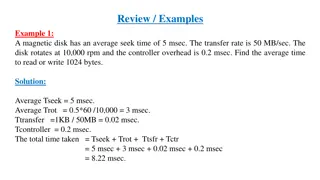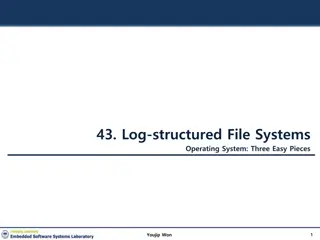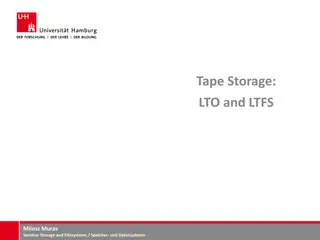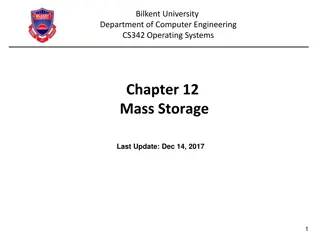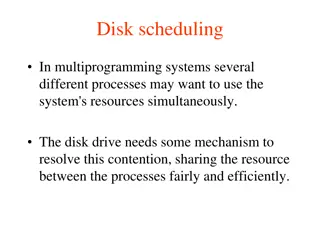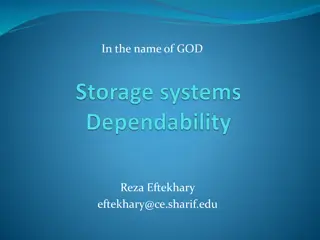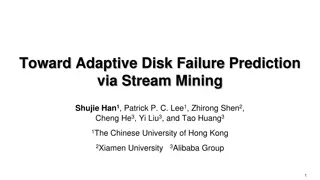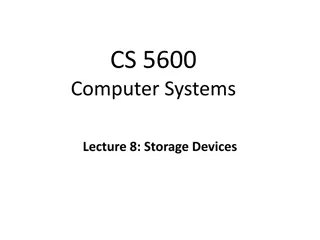Understanding Disk Storage Systems in Computer Science
Disk storage systems play a crucial role in computer architecture. This tutorial delves into the differences between disks and main memory in terms of access time, capacity calculations, block sizes, rotational delays, and transfer rates. It covers key concepts such as track capacity, surface capacity, disk capacity, cylinder count, valid block sizes, and rotational delay calculations. Gain insights into how disk platters function and the importance of sector sizes, tracks, surfaces, and seek times in disk operations.
Download Presentation

Please find below an Image/Link to download the presentation.
The content on the website is provided AS IS for your information and personal use only. It may not be sold, licensed, or shared on other websites without obtaining consent from the author. Download presentation by click this link. If you encounter any issues during the download, it is possible that the publisher has removed the file from their server.
E N D
Presentation Transcript
Tutorial 8 CSI 2132 Database I
Exercise 1 Both disks and main memory support direct access to any desired location (page). On average, main memory accesses are faster, of course. What is the other important difference (from the perspective of the time required to access a desired page)?
Ans: The time to access a disk page is not constant. It depends on the location of the data. Accessing to some data might be much faster than to others. It is different for memory. The time to access memory is uniform for most computer systems.
Exercise 2 Consider a disk with a sector size of 512 bytes, 2000 tracks per surface, 50 sectors per track, five double- sided platters, and average seek time of 10 msec. 1. What is the capacity of a track in bytes? What is the capacity of each surface? What is the capacity of the disk? 2. How many cylinders does the disk have? 3. Give examples of valid block sizes. Is 256 bytes a valid block size? 2048? 51,200? 4. If the disk platters rotate at 5400 rpm (revolutions per minute), what is the maximum rotational delay? 5. If one track of data can be transferred per revolution, what is the transfer rate?
1. What is the capacity of a track in bytes? What is the capacity of each surface? What is the capacity of the disk? bytes/track = bytes/sector sectors/track = 512 50 = 25K bytes/surface = bytes/track tracks/surface = 25K 2000 = 50, 000K bytes/disk = bytes/surface surfaces/disk = 50, 000K 5 2 = 500, 000K
2. How many cylinders does the disk have? The number of cylinders is the same as the number of tracks on each platter, which is 2000. 3. Give examples of valid block sizes. Is 256 bytes a valid block size? 2048? 51,200? The block size should be a multiple of the sector size. We can see that 256 is not a valid block size while 2048 is. 51200 is not a valid block size in this case because block size cannot exceed the size of a track, which is 25600 bytes.
4. If the disk platters rotate at 5400 rpm (revolutions per minute), what is the maximum rotational delay? If the disk platters rotate at 5400rpm, the time required for one complete rotation, which is the maximum rotational delay, is (1/5400) 60 = 0.011seconds The average rotational delay is half of the rotation time, 0.006 seconds.
5. If one track of data can be transferred per revolution, what is the transfer rate? The capacity of a track is 25K bytes. Since one track of data can be transferred per revolution, the data transfer rate is (25K/0.011) = 2, 250Kbytes/second
Exercise 3 What does it mean to say that a page is pinned in the buffer pool? Who is responsible for pinning pages? Who unpinning pages? is responsible for
Ans: 1. Pinning a page means the pin_count of its frame is incremented. Pinning a page guarantees higher- level DBMS software that the page will not be removed from the buffer pool by the buffer manager. That is, another file page will not be read into the frame containing this page until it is unpinned by this requestor. 2. It is the buffer manager s responsibility to pin a page. 3. It is the responsibility of the requestor of that page to tell the buffer manager to unpin a page.
Exercise 4 Answer Extendible Hashing: the following questions about
1. Explain why local depth and global depth are needed. Extendible hashing allows the size of the directory to increase and decrease depending on the number and variety of inserts and deletes. Once the directory size changes, the hash function applied to the search key value should also change. So there should be some information in the index as to which hash function is to be applied. This information is provided by the global depth.
An increase in the directory size doesnt cause the creation of new buckets for each new directory entry. All the new directory entries except one share buckets with the old directory entries. Whenever a bucket which is being shared by two or more directory entries is to be split the directory size need not be doubled. This means for each bucket we need to know whether it is being shared by two or more directory entries. This information is provided by the local depth of the bucket. The same information can be obtained by a scan of the directory, but this is costlier.
2. After an insertion that causes the directory size to double, how many buckets have exactly one directory entry pointing to them? If an entry is then deleted from one of these buckets, what happens to the directory size? Explain your answers briefly. Exactly two directory entries have only one directory entry pointing to them after a doubling of the directory size. This is because when the directory is doubled, one of the buckets must have split causing a directory entry to point to each of these two new buckets.
If an entry is then deleted from one of these buckets, a merge may occur, but this depends on the deletion algorithm. If we try to merge two buckets only when a bucket becomes empty, then it is not necessary that the directory size decrease after the deletion that was considered in the question. However, if we try to merge two buckets whenever it is possible to do so then the directory size decreases after the deletion.
3. Does Extendible I-lashing guarantee at most one disk access to retrieve a record with a given key value? No minimum disk access guarantee is provided by extendible hashing. If the directory is not already in memory it needs to be fetched from the disk which may require more than one disk access depending upon the size of the directory. Then the required bucket has to be brought into the memory. Also, if alternatives 2 and 3 are followed for storing the data entries in the index then another disk access is possibly required for fetching the actual data record.
4. If the hash function distributes data entries over the space of bucket numbers in a very skewed (non- uniform) way, what can you say about the size of the directory? What can you say about the space utilization in data pages (i.e., non-directory pages)? Let us consider a list of data entries with search key values of the form 2i where i > k. By an appropriate choice of k, we can get all these elements mapped into the Bucket A. This creates 2k elements in the directory which point to just k + 3 different buckets. Also, we note there are k buckets (data pages), but just one bucket is used. So the utilization of data pages = 1/k.
5. Does doubling the directory require us to examine all buckets with local depth equal to global depth? No. Since we are using extendible hashing, only the local depth of the bucket being split needs be examined.
6. Why is handling duplicate key values in Extendible Hashing harder than in ISAM? Extendible hashing is not supposed to have overflow pages (overflow pages are supposed to be dealt with using redistribution and splitting). When there are many duplicate entries in the index, overflow pages may be created that can never be redistributed (they will always map to the same bucket). Whenever a split occurs on a bucket containing only duplicate entries, an empty bucket will be created since all of the duplicates remain in the same bucket. The overflow chains will never be split, which makes inserts and searches more costly.
Exercise 5 Consider a relation R( a, b, c, d) containing 1 million records, where each page of the relation holds 10 records. R is organized as a heap file with un-clustered indexes, and the records in R are randomly ordered. Assume that attribute a is a candidate key for R, with values lying in the range 0 to 999,999. For each of the following queries, name the approach that would most likely require the fewest l/Os for processing the query.
The approaches to consider follow: Scanning through the whole heap file for R. Using a B+ tree index on attribute R.a. Using a hash index on attribute R.a. The queries are: 1. Find all R tuples. 2. Find all R tuples such that a < 50. 3. Find all R tuples such that a = 50. 4. Find all R tuples such that a > 50 and a < 100.
Let h be the height of the B+ tree (usually 2 or 3 ) and M be the number of data entries per page (M > 10). Let us assume that after accessing the data entry it takes one more disk access to get the actual record. Let c be the occupancy factor in hash indexing. From the table below: 1. From the first row of the table, we see that heap file organization is the best (has the fewest disk accesses). 2. From the second row of the table, with typical values for h and M, the B+ Tree has the fewest disk accesses. 3. From the third row of the table, hash indexing is the best. 4. From the fourth row or the table, again we see that B+ Tree is the best.




